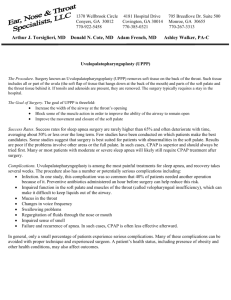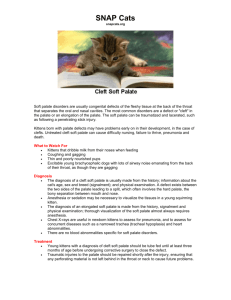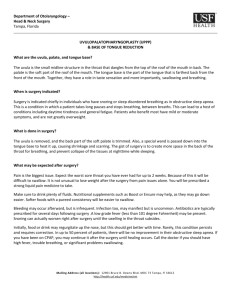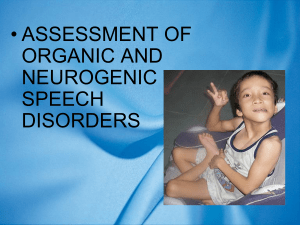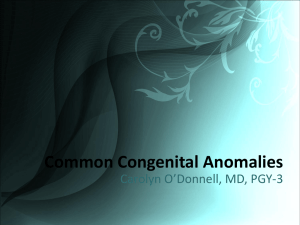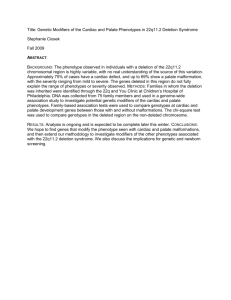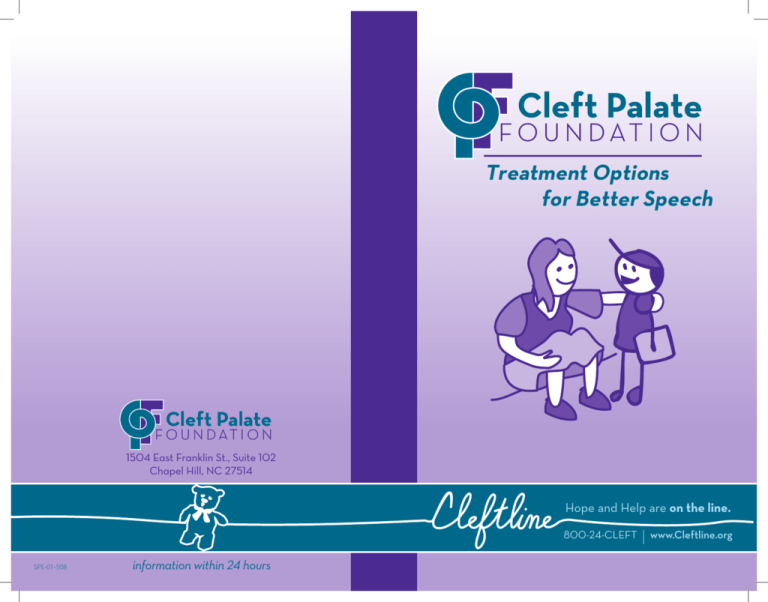
Treatment Options
for Better Speech
1504 East Franklin St., Suite 102
Chapel Hill, NC 27514
Hope and Help are on the line.
800-24-CLEFT
SPE-01-508
information within 24 hours
www.Cleftline.org
Treatment Options
for Better Speech
First Edition
2008 Reprint
Major Contributor to the First Edition:
David Jones, PhD, Speech-Language Pathology
Edited by the 2004 Publications Committee:
Cassandra Aspinall, MSW, Social Work
John W. Canady, MD, Plastic & Reconstructive Surgery
David Jones, PhD, Speech-Language Pathology
Alice Kahn, PhD, Speech-Language Pathology
Kathleen Kapp-Simon, PhD, Psychology
Karlind Moller, PhD, Speech-Language Pathology
Gary Neiman, PhD, Speech-Language Pathology
Francis Papay, MD, Plastic Surgery
David Reisberg, DDS, Prosthodontics
Maureen Cassidy Riski, AuD, Audiology
Carol Ritter, RN, BSN, Nursing
Marlene Salas-Provance, PhD, Speech-Language Pathology
James Sidman, MD, Otolaryngology
Timothy Turvey, DDS, Oral/Maxillofacial Surgery
Craig Vander Kolk, MD, Plastic Surgery
Leslie Will, DMD, Orthodontics
Lisa Young, MS, CCC-SLP, Speech-Language Pathology
Figures 1, 2 and 5 are reproduced with the kind permission of University of
Minnesota Press, Minneapolis, A Parent’s Guide to Cleft Lip and Palate, Karlind
Moller, Clark Starr and Sylvia Johnson, eds., 1990.
Figure 3 is reproduced with the kind permission of Millard DR: Cleft Craft: The
Evolution of its Surgeries. Volume 3: Alveolar and Palatal Deformities. Boston:
Little, Brown, 1980, pp. 653-654
Figure 4 is an original drawing by David Low, MD.
Copyright ©?2004 by Cleft Palate Foundation. All rights reserved. This publication is protected by Copyright. Permission should be obtained from the
Cleft Palate Foundation prior to any reproduction.
i
Table of Contents
Velopharyngeal Dysfunction ..........................................................................................1
Diagnosis and Treatment..................................................................................................2
Surgical Options ....................................................................................................................3
Lengthening the Soft Palate................................................................................3
Pharyngeal Flap........................................................................................................4
Sphincter Pharyngoplasty. ...................................................................................5
Pharyngeal Wall Augmentation..........................................................................6
After Surgery...........................................................................................................................7
Non-Surgical Treatment Options ................................................................................8
Speech Bulb ...............................................................................................................8
Palatal Lift. ..................................................................................................................9
Making a Decision ................................................................................................................9
For More Information .....................................................................................................10
ii
Velopharyngeal Dysfunction
Velopharyngeal dysfunction (VPD) occurs when the opening between the
soft palate and the back wall of the throat (velopharyngeal space) cannot close
properly during speech. This problem results in unwanted escape of air or
sound through the nose during speech. The word velopharyngeal comes from
the words velum, or soft palate, and pharynx, or throat area. Approximately 1525% of children born with cleft palate (with or without cleft lip) will develop
VPD after palate repair. Your doctor or speech-language pathologist may also
use the terms velopharyngeal insufficiency or inadequacy (VPI) to describe this
problem, which may result in hypernasal speech.
Speech sounds are both nasal and oral. When we talk, some sounds are
supposed to come through our noses, like the /m/ and /n/ sounds. You can feel
the vibration in your nose when you say words like “mom” and “no.” Most other
sounds are supposed to come only through our mouths. You should not feel
the same vibration in your nose when you say words like “pop” and “cat.” It is
the closure of the velopharyngeal space that allows us to build up air pressure
in the mouth and make these consonant sounds (see Figure 1a). This closure
occurs when the soft palate lifts up and back to contact the back of the throat,
possibly with the walls of the throat moving in to meet it. People with VPD
cannot close this space effectively and therefore have air coming through their
noses when they should not (see Figure 1b).
1
In general, VPD occurs for one of two reasons. First, if there isn’t enough
tissue in the palate for the surgeon to use during palate repair, the repaired soft
palate may be shorter than normal. As a result, the soft palate may be too
short to make contact with the back wall of the upper throat (see Figure 1b).
Second, it is possible that the muscles that move the soft palate and walls of
the upper throat are not able to function properly to move these structures far
or fast enough to make the velopharyngeal space close when needed. In
some instances, a combination of these factors can result in VPD.
Diagnosis and Treatment
When someone’s speech sounds nasal, it usually means that VPD is present.
However, in order to determine the cause of VPD, it is necessary to look at the
velopharyngeal structures during speech. A video x-ray machine can allow
doctors to view the velopharyngeal mechanism from the side and the front
(videofluoroscopy). They can also use a narrow, flexible scope through
the nostril to view the palate from above. This procedure is called
video-endoscopy because the flexible scope is attached to a video camera.
Your cleft palate team may recommend that one or both of these
procedures be done to help diagnose the problem. By viewing how the soft
palate and walls of throat are working during speech, the cleft palate team can
2
determine, 1) whether a velopharyngeal gap is present, 2) the size and the
location of the velopharyngeal gap, and 3) what structures are actually moving
during speech. This information is important because it helps the cleft palate
team determine how the VPD should be treated.
The purpose of treating VPD is to eliminate or significantly decrease
hypernasality and excessive nasal air escape during speech. Surgical treatment can change the size and shape of the velopharyngeal space so that when
your child speaks, air and sound will be directed out of the mouth rather than
into the nose. Sometimes a small amount of nasality is still present after treatment, but perhaps not enough for most people to notice.
Children with VPD may try to compensate for their lack of velopharyngeal
closure. In order to try to make speech sounds that other people make, they
may use their throats or tongues in ways that actually make it more
difficult to understand their speech. These speech patterns are often called
compensatory articulations. Treating VPD will not automatically stop your
child from making speech sounds incorrectly. Like any habit, it takes effort to
change these speech patterns. Speech therapy can often help the child
re-train his or her mouth to make speech sounds correctly, even before
physical treatment of VPD.
Surgical Options
You should consult with your cleft palate team about what surgical
choices may be best for you or your child. The most common surgeries are
described below.
Lengthening the Soft Palate
A lengthening procedure involves the surgeon re-operating on the soft
palate. There are usually two situations in which this procedure may be selected. First, in some people the soft palate moves well but is slightly short. In this
case, surgery involves making the soft palate longer so that when it moves, it
can make contact with the back wall of the upper throat during speech.
Second, in some people the muscle that moves the soft palate is not in the correct position. In this case, surgery involves repositioning the muscle so that the
soft palate will move better while also lengthening the soft palate somewhat.
With improved length and mobility, the soft palate should now make contact
with the back wall of the upper throat.
3
Pharyngeal Flap
During the pharyngeal flap procedure, the surgeon makes incisions in the
back wall of the throat and creates a flap of tissue. The surgeon attaches the
free end of the flap to the soft palate. The result is a permanent bridge
of tissue between the throat and the soft palate that helps reduce the
velopharyngeal space (see Figure 2a). Ideally, the flap does not totally block
the opening into the nose. A view of the pharyngeal flap from above
(see Figure 2b) shows that there are openings, or ports, on either side that
should allow a person to breathe through his or her nose.
This procedure tends to work best for patients who have good movement
of the side walls of the upper throat, because it is this movement that closes
the openings, or ports, during speech. During speech, the side walls of the
upper throat move in and make contact with the flap on either side, thus
closing off the velopharyngeal space. When not speaking, the side walls go
back to the rest position.
4
Sphincter Pharyngoplasty
Like pharyngeal flap surgery, the sphincter pharyngoplasty changes the
shape of the velopharyngeal space, but it does it in a different way. Instead of
lifting one flap from the back wall of the throat, the surgeon makes incisions
along each side of the throat in order to create two flaps of tissue. These two
flaps are then pulled up and attached to the sides and back of the throat. The
result is a permanent ring of tissue that lines the walls of the upper throat and
makes the velopharyngeal space smaller (see Figure 3).
While pharyngeal flap surgery creates two holes near the sides of the throat
for air to pass through, sphincter pharyngoplasty creates one hole in the
middle of the throat surrounded by the new ridge of tissue. As the soft palate
elevates during speech, it will make contact with this ridge to close the
smaller velopharyngeal space. This procedure tends to work best for patients
who have good soft palate movement and poor movement of the side walls of
the upper throat.
5
Pharyngeal Wall Augmentation
Some people with VPD already have a rather small velopharyngeal
space and may need a pharyngeal wall augmentation procedure. In this case,
the surgeon creates a bulge on the back wall of the upper throat so that part
of the wall is closer to the soft palate. The surgeon can add bulk to the back
wall of the upper throat by either: a) injecting or inserting some artificial
material, b) injecting or inserting fat or cartilage from the person’s body; or c)
creating a flap (similar to a pharyngeal flap), rolling it up, and sewing it into the
back wall of the throat.
After surgery, the velopharyngeal space is smaller because of the added bulge
along the back wall of the upper throat. As the soft palate elevates
during speech, it will make contact with the bulge to close the small
velopharyngeal space (see Figure 4). This procedure tends to work best for
patients who have good palatal movement and a very small velopharyngeal gap.
6
After Surgery
After surgery, the palate and throat will be swollen and bruised for several
days. The feeling of nasal congestion is common during this time, and speech
may sound stuffy (denasal or hyponasal) for 7-10 days or longer. The stitches
in the palate and throat will dissolve a few days after surgery. Your surgeon will
give you instructions about foods that are appropriate to eat during this period. Questions about the duration of the surgery, length of hospital stay, managing pain, and problems to watch for after surgery can be answered by your
surgeon and your team.
Surgical treatment has been shown to be very successful in treating VPD.
However, there are possible problems as well. Sometimes the pharyngeal flap
or the sphincter pharyngoplasty reduces the size of the velopharyngeal space
more than desired. When this happens, it may be more difficult to
breathe through the nose, and speech could sound stuffy for months (or perhaps longer) after surgery.
If nasal breathing becomes extremely difficult, a person may be unable to
breathe normally during sleep and could develop sleep apnea. In extreme
cases, another surgery may be needed to remove some of the tissue put in
place during the first surgery. The surgeon will try to remove enough tissue to
improve nasal breathing but still leave enough tissue to help with the original
VPD problem. Keep in mind that surgery cannot solve every speech problem,
especially when a person’s airway cannot tolerate the extra tissue needed to
improve speech.
Another possible problem is that the size of the velopharyngeal space may
still be too large after surgery. The tissue intended to make the space smaller
might pull away from the throat, or the tissue might shrink too much when
the back of the throat heals. If this happens, you may still hear air and sound
escaping out of the nose during speech. In some cases, an additional surgery
may be needed to reduce the size of the velopharyngeal space further.
Again, surgery may not be able to solve every person’s speech problems.
7
Non-Surgical Treatment Options
In some instances, surgery may not be the best option for people with VPD,
either because they are not healthy enough to undergo an anesthesia or
surgery, or because the cleft palate team believes that surgery would not be
successful. In these cases, VPD may be treated with a removable appliance
(prosthesis) that assists velopharyngeal closure during speech. These prostheses are made by a dental specialist such as a prosthodontist. The two main
types of appliances are the speech bulb and the palatal lift.
Speech Bulb
A speech bulb is a plastic ball that fits into the velopharyngeal space. It is
attached to a plastic plate that is fitted to the roof of the mouth and held in
place by wire clasps on some of the teeth (see Figure 5b). It looks like an orthodontic retainer with an extension on the end. The size of the bulb will vary
depending on the size of the velopharyngeal space and how much the soft
palate and pharyngeal walls are able to move. During speech, the walls of
the upper throat move in and make contact with the bulb, closing the velopharyngeal space and preventing air and sound from escaping into the nose.
The appliance is removed at night before bedtime.
8
In some cases, the speech bulb is a permanent solution to VPD. That is,
although it is removable, some patients may wear it daily for the rest of their
lives. However, it usually is a temporary solution until a person is considered
a good candidate for surgery. In a few cases, the speech bulb can stimulate
more velopharyngeal movements. In these cases, the bulb can be made
smaller over time.
Palatal Lift
A palatal lift is similar to a speech bulb in that it consists of a plastic plate on
the roof of the mouth that is clasped to several teeth. However, its extension is
a wider plastic paddle that extends straight back to lift the soft palate up and
back, closing the velopharyngeal space (see Figure 5c). This appliance is also
removed at night before bedtime.
The palatal lift raises the soft palate into the velopharyngeal space and
holds it up whether the person is speaking or not. In its lifted position, the soft
palate and/or the walls of the upper throat close the velopharyngeal space.
There are still small openings on the sides to allow a person to breathe through
the nose. The palatal lift is usually appropriate for patients who have a soft
palate of normal length and little movement of the soft palate or walls of the
throat. This problem could be caused by cleft palate, but it is usually the result
of a neurologic disorder.
Making a Decision
It is common for people to ask which of the treatment approaches is best.
To answer this question, it is important to remember that there are different
causes of VPD. The approach to treatment must be designed to address the
cause of the problem. Your health care providers must consider such factors as
the size of the velopharyngeal gap, the length of the soft palate, and what parts
of the palate and/or throat move well during speech. Because these factors
vary from person to person, the treatment approach that is appropriate for one
person may not be appropriate for another. Talk with members of your cleft
palate team for more information.
9
For More Information
Las publicaciones de la Fundación del Paladar Hendido también se ofrecen
en español. Favor de llamarnos para recibir copias en español.
This publication and many others have been produced by:
The Cleft Palate Foundation
1504 East Franklin Street, Suite 102
Chapel Hill, NC 27514
1.800.24.CLEFT (or 1.800.242.5338)
919.933.9044
919.933.9604 Fax
info@cleftline.org
www.cleftline.org
Cleftline – 1.800.24.CLEFT
(1.800.242.5338)
The Cleft Palate Foundation (CPF) maintains a growing collection of booklets
and fact sheets that present an introduction to and explanation of many
elements of cleft and craniofacial care and treatment. All publications are
authored and regularly revised by representatives of professional disciplines
serving the field of cleft and craniofacial care and treatment.
A publications order form for institutions including current pricing, bulk order
rates and shipping and handling fees may be accessed at the CPF website or
by calling the Cleftline at 1.800.24.CLEFT. All fact sheets are available at the
website as open-access, PDF documents. Families, patients, students and other
individuals may request complimentary packets of publications by emailing
info@cleftline.org or by calling the Cleftline.
To date, the Cleft Palate Foundation has shared over 7,000 Gund Teddy Bears
with repaired cleft lips with children and families all over the world. Please visit
www.cleftline.org or call the Cleftline for more information about our bears.
If you are interested in helping us continue in our mission, please contribute to
the CPF Cleftline Fund. Visit www.cleftline.org or call the Cleftline to make
your donation today! Thank you.
HOPE AND HELP ARE ON THE LINE
10
Notes
Notes
Notes
Developing Good Speech
1504 East Franklin St., Suite 102
Chapel Hill, NC 27514
Hope and Help are on the line.
800-24-CLEFT
SPE-01-10/08
information within 24 hours
www.Cleftline.org

